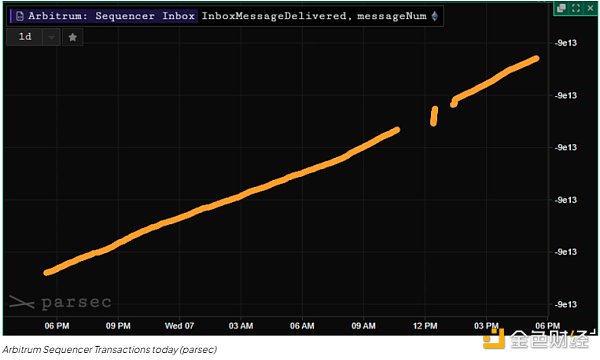Exhaustion of Gas fee causes Arbitrum to pause transaction processing for one hour
Arbitrum pauses transactions for an hour when Gas fee is exhausted.Author: Tim Craig, DLNews; translation: 松雪, Blocking
• After its core software – Sequencer – ran out of gas fees, Arbitrum paused transaction processing for an hour.
• Arbitrum has only one Sequencer and needed manual replenishment of Ether yesterday.
• Although Arbitrum is running again, the event highlights the single point of failure of blockchain.
- Analysis of SEC’s “Trigger” for Launching Crypto War and 5 Possible Outcomes
- Viewpoint: Why the US Congress should regulate cryptocurrency
- Reflections on the SEC’s lawsuit against Binance: What are the reasons behind the controversy?
Arbitrum is a layer 2 blockchain that stopped processing transactions for about an hour, leaving the network with over $2.24 billion in deposits at a standstill. The reason was an error that caused the central control sequencer of the blockchain to run out of funds to pay gas fees.
“An error occurred on Sequencer that caused its batch to revert on-chain. When the batch reverted, the Sequencer does not refund the gas cost of sending the batch,” Blockingtrick McCorry, a developer with the Arbitrum Foundation, told DL News.
He said that when this happened, the Sequencer ran out of ETH, “which was manually replenished when the error was fixed.”
Around 11:40 a.m. London time, developers on the Arbitrum Discord server began reporting that they were unable to connect to the Sequencer – software that bundles transactions and sends them to the Ethereum network for confirmation.
Layer 2 blockchains like Arbitrum need to send transactions back to Ethereum for finality, meaning that transactions are permanently etched onto the Ethereum blockchain and cannot be changed.
Chain records show that the Sequencer ran out of its Ether, and without Ether to pay fees, the Sequencer was unable to send transactions to Ethereum, causing Arbitrum to stall.
 Arbitrum Sequencer Transaction (Blockingrsec)
Arbitrum Sequencer Transaction (Blockingrsec)
Arbitrum currently has only one Sequencer that processes transactions. It is operated by Offchain Labs, the company that created and manages the network.
After about an hour of transaction pause, Arbitrum now seems to be working again. At around 12:27 p.m., the wallet that sent funds to the Arbitrum multi-signature wallet sent a total of 1.4 Ether to Sequencer, enabling it to start sending transactions to Ethereum again.
Since its launch in May 2021, Sequencer has only been manually recharged four times.
Offchain Labs did not immediately respond to a request for comment.
The incident has drawn attention to how networks like Arbitrum, which depend on centralized control points, rely on Ethereum’s security and network decentralization. Offchain Labs previously stated that it plans to decentralize the Sequencer of Arbitrum in the future.
 Arbitrum’s total value locked, a measure of the amount of DeFi investors’ deposits
Arbitrum’s total value locked, a measure of the amount of DeFi investors’ deposits
The price of Arbitrum’s token (also known as Arbitrum) remained largely unchanged throughout the outage. At the time of writing, its trading price is around $1.14.
We will continue to update Blocking; if you have any questions or suggestions, please contact us!
Was this article helpful?
93 out of 132 found this helpful
Related articles
- Analysis: What are the common characteristics of cryptocurrencies listed as securities by the US SEC?
- Dune Dashboard Data: As of now, there are a total of 117,849 Lens Profiles
- Source and Security of Arbitrum Assets
- Core developers of the Ethereum execution layer have confirmed the Cancun EIP list, which includes five EIPs such as EIP-1153, EIP-4788, and EIP-4844.
- EN: Binance.US keeps records of all user funds, which have never left the platform unless withdrawn by the user.
- Discussing the SEC’s lawsuit against Binance: Years of regulatory balance disrupted, optimistic about the final outcome
- Latest updates on regulatory events: CZ releases internal memo, Gensler criticizes two exchanges again.






